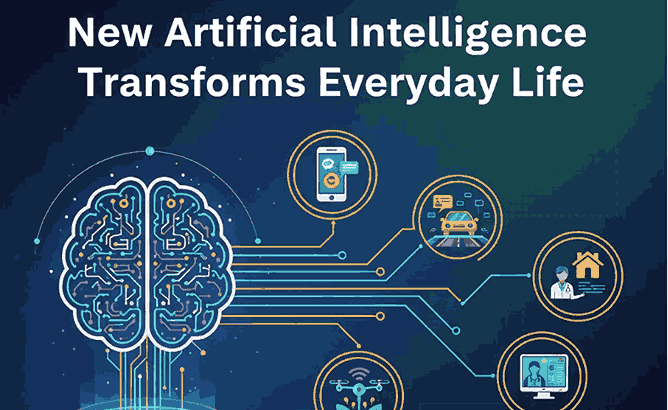Table of Contents
- Introduction
- Understanding AI and Its Core Capabilities
- Real-World AI Application Examples
- AI in Business
- AI in Design and Creativity
- AI in Healthcare
- AI in Education
- AI in Transportation
- How Designers and Brands Can Benefit from AI
- Recommended Fonts for Creative AI Projects
- Conclusion
- References
1. Introduction
Artificial Intelligence (AI) has moved far beyond science fiction—it’s now an essential part of our everyday world. From personalized shopping recommendations to self-driving cars, AI is redefining how we live, work, and create. For designers, marketers, and creative professionals, understanding the most practical AI application examples can inspire new ideas and open opportunities for innovation.
This article explores how AI works across different industries, its most impactful use cases, and how creative brands can integrate AI-driven tools to stay ahead of the curve.

2. Understanding AI and Its Core Capabilities
At its core, AI refers to the simulation of human intelligence in machines. It involves systems that can learn from data (machine learning), interpret visuals (computer vision), understand language (NLP), and make decisions autonomously (automation).
The beauty of AI lies in its versatility—it can be applied to almost any industry, from finance and healthcare to art and entertainment. Let’s take a look at some of the most fascinating AI application examples shaping today’s digital world.
3. Real-World AI Application Examples
AI in Business
In business, AI helps companies automate repetitive tasks, analyze customer behavior, and improve decision-making. Tools like chatbots, predictive analytics, and recommendation engines are widely used to enhance customer experience and boost sales.
- Example: Amazon uses AI-powered algorithms to suggest products based on browsing history and purchase patterns.
- Example: Salesforce Einstein uses AI to predict customer needs and personalize marketing strategies.
AI-driven automation also streamlines administrative work, freeing up time for creative and strategic thinking.
AI in Design and Creativity
AI is becoming a powerful partner for designers and artists. Generative design tools allow creators to input goals or parameters, and the system generates multiple design options automatically.
- Example: Adobe Firefly and DALL·E 3 help designers create high-quality visuals in seconds.
- Example: Canva’s AI Design Assistant suggests templates, fonts, and color palettes for faster, more cohesive designs.
For creative projects, pairing strong AI visuals with professional fonts enhances brand consistency and visual appeal. Try fonts like:
These modern typefaces perfectly match AI-themed visuals and futuristic design styles.
AI in Healthcare
In healthcare, AI assists in diagnosing diseases, managing patient data, and even predicting outbreaks.
- Example: IBM Watson Health analyzes complex medical data to help doctors make more accurate diagnoses.
- Example: PathAI uses AI to improve accuracy in pathology, ensuring faster and more reliable test results.
With AI’s help, healthcare professionals can provide better care while saving time and resources.
AI in Education
AI is reshaping how students learn and teachers teach. Personalized learning platforms use algorithms to adapt lessons to each student’s pace and style.
- Example: Duolingo uses AI to tailor language lessons based on individual performance.
- Example: Coursera and Khan Academy use AI to recommend courses that align with users’ goals.
In creative education, AI tools also support design students by generating logo mockups, layout ideas, and marketing visuals instantly.
AI in Transportation
AI powers the future of smart mobility. From autonomous vehicles to optimized traffic systems, it’s revolutionizing how we move.
- Example: Tesla’s Autopilot uses neural networks to interpret surroundings and make split-second driving decisions.
- Example: Google Maps leverages AI for real-time route optimization and traffic prediction.
The integration of AI reduces congestion, enhances safety, and improves the overall commuting experience.
4. How Designers and Brands Can Benefit from AI Application Examples
For creative professionals, AI is not a replacement—it’s a collaborator. Whether you’re a designer, marketer, or entrepreneur, AI helps you:
- Automate repetitive tasks (like resizing graphics or tagging images).
- Generate new design concepts faster.
- Analyze engagement data to improve visual content.
- Create mockups and product visuals using AI-based image generation tools.
By combining AI tools with high-quality fonts and layouts, brands can maintain both efficiency and creativity.

5. Recommended Fonts for Creative AI Application Examples Projects
To complement AI-driven visuals, typography plays a vital role in maintaining professionalism and consistency. Here are some recommended fonts from Edric Studio:
- Airframe Sans Serif Font: Clean and geometric, ideal for futuristic branding.
- Anamelia Sans Serif Font: Elegant and minimal, perfect for AI and tech design projects.
- Aldora Futuristic Font: Bold and modern, great for AI-themed visuals.
- Blacked Font: Strong and tech-inspired, suitable for gaming or technology brands.
Pairing these fonts with AI-generated art ensures your brand identity remains visually engaging and professional.
6. Conclusion
AI is not just a technological trend—it’s the creative force shaping the future of every industry. From healthcare to design, the examples above demonstrate how artificial intelligence enhances innovation, efficiency, and personalization.
For designers and brands, embracing AI applications means unlocking endless creative possibilities while maintaining a strong, consistent brand identity. Combine these intelligent tools with premium fonts from Edric Studio to make your next project stand out beautifully.
